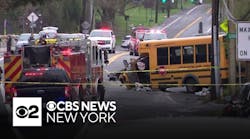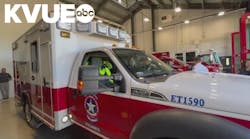July 1, 1898: PHILADELPHIA - A woman apparently distraught over the loss of a child set fire to her home on Locust Street in West Philadelphia. The kerosene-fed flames soon filled the structure. Arriving firemen were unable to revive two of three people rescued. The woman wandered away in a daze and was struck and killed by a trolley car a few blocks from the fire.
July 1, 1898: NEW YORK CITY - An explosion in the Yale-Downing Building on Warren Street blew the windows out of the adjacent Postal Telegraph Building. Postal workers scrambled to safety as flames belched across the narrow shaftway between the buildings. Firemen arrived moments after the last of the shattered plate-glass windows rained down from the seventh floor. Using standpipe streams the firemen pushed the flames back into the fire building and extinguished the blaze within 30 minutes.
July 2, 1898: BOSTON - A one-story, 85-by-630-foot storage warehouse known as the Atlas Stores caught fire during the night. Fueled by 1,700 bales of wool and large quantities of cotton, rags, furniture and other flammables the structure was soon blazing. As firemen arrived at the waterfront structure, it was apparent that a ship, the U.S.S. Minnesota, moored nearby, was quickly becoming an exposure problem. Two hundred twenty-five sailors joined the Boston firemen in a heroic battle that saved the ship and salvaged much of the warehouse.
July 2, 1898: UNIONTOWN, PA - A devastating fire that began in the basement of J.E. Balsley's Restaurant in the Wilson Building on Main Street was quickly spread by high winds. Two firemen were reportedly on the roof as it collapsed at the height of the blaze. Another fireman from the Collingsville Fire Company was seriously injured when he was struck by a falling ladder.
July 3, 1898: LOUISVILLE, KY - The immense plant of the Globe Refining Co. was destroyed by a late-night fire. Water problems hampered firefighting efforts. The cause of the blaze was believed to be spontaneous combustion.
July 4, 1898: In what was becoming a national epidemic of fires, explosions, injury and death, Americans celebrated their independence. The following are only the highlights: NEW YORK CITY - Firemen extinguished over 40 building fires caused by fireworks, including a skyrocket-initiated three-alarm blaze in a large stable on East 75th Street that killed two horses. ORANGE, NJ - A firecracker started a blaze in the rear of a small grocery store on Nassau Street. Flames spread to a large hat factory and eight homes before firemen could gain control of the fire. HACKENSACK, NJ - Firecrackers set fire to a large barn and the flames soon ignited another nearby barn.
July 5, 1898: DUNSAIR, CA - A fire that started in the Arlington House soon spread into the business district. Two blocks of the town, located in Sisklyou County, were soon blazing. Homes and railroad buildings were also destroyed.
July 5, 1898: ST. LOUIS - A general-alarm fire at the fairgrounds raced through the stable areas while racing was in progress. Firemen arrived to find a number of stables blazing and fire leaping from one structure to the next. A number of valuable horses were destroyed, but more than 150 were cut loose and fled the smoke and flames.
July 6, 1898: CHICAGO - A curious story came to light concerning firemen and flags. Large American flags placed in celebration of Independence Day hampered firemen on two separate occasions. Fires occurring a few days apart on South Jefferson Street and Randolf Street both featured the patriotic obstacles. In both cases the oversized flags hampered firemen placing ladders, but they refused to remove the national colors and worked around them.
July 9, 1898: CLEVELAND - A fast-moving fire broke out around noon in the Britton Printing Co. on Erie Street. The flames drove employees to various windows seeking escape. With fire closing in, three civilians jumped from third-, fourth- and fifth-floor windows. Fireman John Callahan was killed by falling terra cotta.
July 10, 1898: PITTSBURGH - A mysterious fire originated in the stable in the rear of the World's Theater on Federal Street. Flames soon filled the theater and from there communicated to adjoining buildings. In an incredibly short time, the entire area of the lower side of Federal Street, from the Sixth Street bridge to the Boyle Block, was in ruins.
July 27, 1898: NEW YORK CITY - A water department employee entered a manhole on Second Avenue to inspect a water valve and was quickly overcome by escaping gas. A fellow worker entered the hole to help and was also overcome. A nearby fire box was pulled by a third worker and firemen were on scene in minutes. Realizing that the firemen had only moments to react and that they too would probably be rendered unconscious by the gas, a fireman entered the hole with a rope tied around him. He managed to tie a rope around one of the victims before passing out. He was pulled up and his victim followed. Another fireman entered and accomplished the same feat, being removed after he was knocked out. Both water department workers succumbed to the gas, but the firemen were revived.
CENTENNIAL CELEBRATIONS: The Barrington, IL, Fire Department was incorporated on June 15, 1898. Members will be celebrating the anniversary throughout the year … The Leonia, NJ, Volunteer Fire Department was established on July 15, 1898 with two companies operating a hand-drawn hose cart and a hook-and-ladder pulled with drag ropes … The Pittsford, NY, Fire Department is celebrating its 100th anniversary with a parade on July 18, 1998. Pittsford Village Active Hose Company 1 was founded by 25 charter members on Nov. 29, 1898; two days later, another 23 volunteers formed Iroquois Hose Company 1.
TIME CAPSULE
July 9, 1943: 9 Chicago Firemen Die In Building Collapse
A fire was discovered in an old four-story brick building at 1:50 A.M., a structure Chicago firemen had operated in at 8:30 P.M. the day before. Sparks from a defective chimney of the building next door apparently started both blazes. Firemen arrived and began to drag their hoselines in to do battle with the flames for a second time in a little over six hours. Four alarms were transmitted, bringing 30 fire companies and 160 men to the scene.
Weary teams pulled hose up to the fourth-floor landing. About 20 firemen were on the various landings handling the hose when Chief Adelbert White dashed up, ordering everyone outside. As he approached the fourth floor, the roof fell in, sending heavy timbers and other debris crashing down on the stairway, which gave way. The firemen fell with the landings, many all the way into the cellar. White was pinned beneath a large beam and was extricated by a fireman before making his way out of the building.
The front wall of the building stood with a major crack running through it. This extremely dangerous condition did not deter the heroic efforts of the Chicago firemen, who immediately entered the collapse area and began rescue operations on their trapped brothers.
All hoselines were shut off except one used to control any fire near those trapped. Holes were breached from the adjoining basement to provide another avenue of approach. For six hours, the firemen cleared debris with the wall looming over their heads before reaching the first victim. One by one, severely injured firemen were freed from the mangled wreckage and rushed to hospitals. Many firemen survived the collapse, but sadly nine men would answer their last alarm.
Paul Hashagen
Compiled by Paul Hashagen




